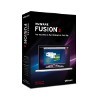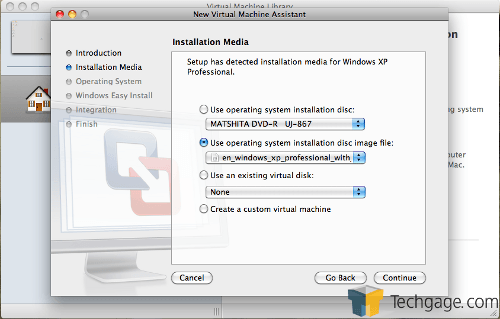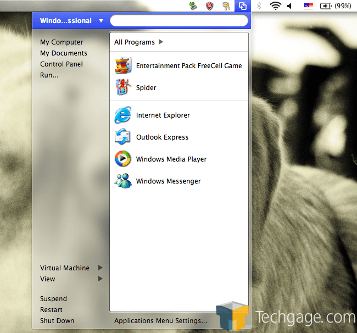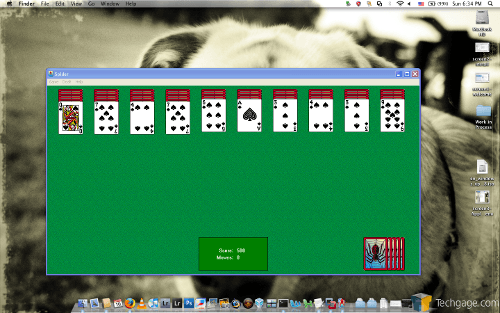- Qualcomm Launches Snapdragon 4 Gen 2 Mobile Platform
- AMD Launches Ryzen PRO 7000 Series Mobile & Desktop Platform
- Intel Launches Sleek Single-Slot Arc Pro A60 Workstation Graphics Card
- NVIDIA Announces Latest Ada Lovelace Additions: GeForce RTX 4060 Ti & RTX 4060
- Maxon Redshift With AMD Radeon GPU Rendering Support Now Available
VMware Fusion 3 – Windows on the Mac Made Easy

Own a Mac, but require the use of Windows from time to time? With today’s robust virtualization solutions, there are better alternatives than rebooting with Bootcamp or using emulation. Fusion 3 is one of these, and we put it to the test to see if it’s worth its $80 price tag, and also whether or not free alternatives are the more attractive choice.
Page 2 – Installing a Virtual Machine
Whether you are migrating from Windows to Mac for the first time, testing out a new version of Windows or just trying to run some applications that are Windows-only, it all starts with building your virtual machine. There are three ways you can do this – download an already built and configured “virtual appliance”, install a new OS on a virtual “blank disk” or migrate an entire existing Windows installation.
The easiest option is to download a pre-built appliance, which is nothing more than a couple clicks and a (usually long) download away. The VMWare appliance library is fairly robust, even including a 30-day trial version of Windows Server 2003. VMWare touts this feature for “trying out new versions” of Windows, but I have to say that I’m a little unimpressed here – the only Microsoft-provided version is the Server 2003 machine.
Although Windows 7 builds exist, they’re limited to ‘beta’ and ‘RC’ versions, which is a shame since Microsoft offers a 30-day no activation trial of Windows 7 if you grab the ISO by some less-than-ethical means. That being said, there’s some great trial versions of Linux that are already up, running and pre-configured – a nice perk for those who’d like to try but are too scared to do the whole install.
The second option is what I like to call the “Windows Lite” choice, because it’s great for people (like me) who don’t use Windows much but need the occasional program. Just grab your disc (or ISO image) and slap it in, along with your license key and desired username/password. Two mouse clicks and twenty minutes later (literally), you’ll have a fully installed Windows running inside of your Mac. That’s all there is to it – VMWare chooses some defaults based on the OS that you installed so that the system can do what it needs to (you can edit these if you’d like), and then you go get a sandwich or do something else on your computer.
Finally, there’s the migration assistant. Though I normally frown on these overly cumbersome options that migrate your whole old, bloated, crashing heap of a Windows partition (isn’t this why you switched?!), I’ve come to really appreciate the purpose. Particularly if you’d like to use your Mac for work, this option is great.
A quick installation of the VMWare PC Migration Agent on the Windows PC will give you a 4-digit security password. Enter that password on your mac, leave both computers powered up on the same network, and go to dinner (this takes a bit longer than a sandwich). Fusion will make a complete image of your current PC hard drive and turn it into a virtual machine, with all settings intact.
Migration is a great way to keep your documents, settings, and comfortable environment if you’re new to the Mac, and its ease-of-use makes this a clear winner. However, I think that this mode is probably the most unsung hero of a business user. Many corporate environments will create a “basic” image to move new PCs into the office with the proper software installed and licensed already. So if you mix a clean install with all of the programs you need with the “Unity” view feature of Fusion, you have a great way to add Macs into your office even if many programs are Windows-only.
Speaking of Unity, let’s get to that now…
Unity View – a.k.a. “Why I bought Fusion”
The title of this section might be a bit of a strong statement, but it’s also about as true as I can make it. Unity View is one of the driving forces behind buying VMWare Fusion. It takes your programs from Windows and seamlessly makes them a part of your Mac OS environment. They can be maximized or minimized, copied and pasted from or to, and even can reside on your application dock. Click the icon, and VMWare boots up the virtual machine (if it’s not running already) and runs the program – without ever seeing the Windows desktop. It’s the closest thing you can get to just having Windows programs “work” on your mac.
Applications run in the Unity view will still be skinned by the Windows program, meaning you will be able to tell one from your mac (unless you run WindowBlinds or another program). However, they will otherwise behave like Mac apps – the same shortcut keys you use in the mac will be available for the application. The taskbar will show up right by your Bluetooth/WiFi. An “Applications” icon will also be there, giving you essentially a duplicate of your “Start” menu at any time to launch applications you’ve not linked things to the dock, and to control the virtual machine).
Expose and Spaces will both see any running Windows programs and treat them just like Mac programs, allowing you to switch between applications with ease. In fact, the only downside to this view is that running in this mode is not compatible with Aero, so you lose the pretty transparency effects of the new Windows versions. It’s a small price to pay for running Windows apps both seamlessly and yet without the bugs of emulation.
Support our efforts! With ad revenue at an all-time low for written websites, we're relying more than ever on reader support to help us continue putting so much effort into this type of content. You can support us by becoming a Patron, or by using our Amazon shopping affiliate links listed through our articles. Thanks for your support!







